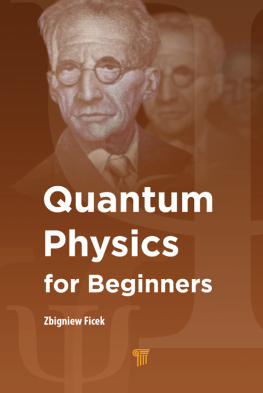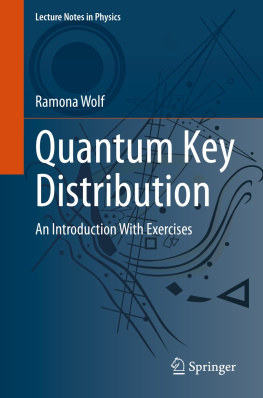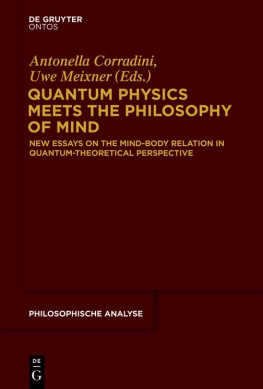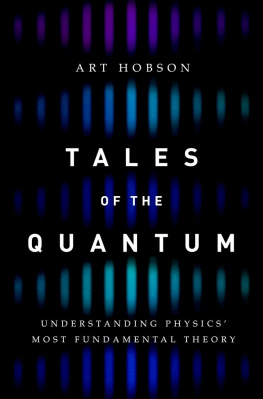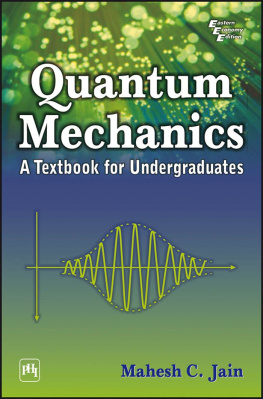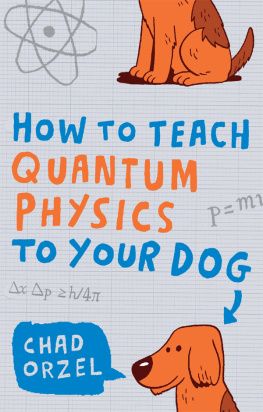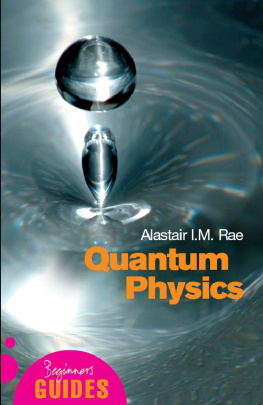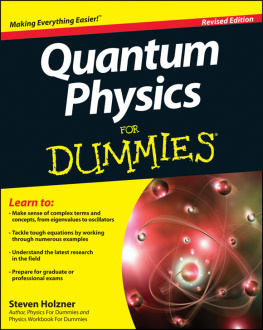Quantum Physics for Beginners
Zbigniew Ficek

CRC Press
Taylor & Francis Group
6000 Broken Sound Parkway NW, Suite 300
Boca Raton, FL 33487-2742
2016 by Taylor & Francis Group, LLC
CRC Press is an imprint of Taylor & Francis Group, an Informa business
No claim to original U.S. Government works
Version Date: 20160602
International Standard Book Number-13: 978-1-138-03159-3 (eBook - EPUB3)
This book contains information obtained from authentic and highly regarded sources. Reasonable efforts have been made to publish reliable data and information, but the author and publisher cannot assume responsibility for the validity of all materials or the consequences of their use. The authors and publishers have attempted to trace the copyright holders of all material reproduced in this publication and apologize to copyright holders if permission to publish in this form has not been obtained. If any copyright material has not been acknowledged please write and let us know so we may rectify in any future reprint.
Except as permitted under U.S. Copyright Law, no part of this book may be reprinted, reproduced, transmitted, or utilized in any form by any electronic, mechanical, or other means, now known or hereafter invented, including photocopying, microfilming, and recording, or in any information storage or retrieval system, without written permission from the publishers.
For permission to photocopy or use material electronically from this work, please access www.copyright.com (http://www.copyright.com/) or contact the Copyright Clearance Center, Inc. (CCC), 222 Rosewood Drive, Danvers, MA 01923, 978-750-8400. CCC is a not-for-profit organization that provides licenses and registration for a variety of users. For organizations that have been granted a photocopy license by the CCC, a separate system of payment has been arranged.
Trademark Notice: Product or corporate names may be trademarks or registered trademarks, and are used only for identification and explanation without intent to infringe.
Visit the Taylor & Francis Web site at
http://www.taylorandfrancis.com
and the CRC Press Web site at
http://www.crcpress.com
Quantum mechanics is very puzzling.
A particle can be delocalized,
it can be simultaneously in several energy states
and it can even have several different identities at once.
Serge Haroche*
Quantum physics, also known as quantum mechanics or quantum wave mechanicsborn in the late 1800sis a study of the submicroscopic world of atoms, the particles that compose them and the particles that compose those particles. In 1800s, physicists believed that radiation is a wave phenomenon and matter is continuous; they believed in the existence of ether and had no ideas of what charge was. A series of the following experiments performed in late 1800s led to the formulation of quantum physics:
- Discovery of the electron
- Discovery of X-rays
- Observation of photoelectric effect
- Observation of discrete atomic spectra
Especially important among these was the interpretation of the spectrum of blackbody radiation that led to the breakdown of the equipartition theorem for electromagnetic radiation.
This textbook covers the background theory of various effects discussed from first principles, and as clearly as possible, to introduce readers to the main ideas of quantum physics and to teach the basic mathematical methods and techniques used in the fields of advanced quantum physics, atomic physics, laser physics, nanotechnology, quantum chemistry, and theoretical mathematics. It also describes some of the key problems of quantum physics, concentrating on the background derivation, techniques, results, and interpretations. The book can be understood by a reader with little or even no previous knowledge of modern and quantum physics. It will help the readers learn how it comes about that microscopic objects (particles) behave in unusual ways called quantum effects, what the term quantum means, and where this idea came from. The book makes no attempt to a complete exploration of all predictions of quantum physics, but it is hoped that the predictions and problems explored in it will provide a useful starting point for those interested in learning more. It intends to explore problems that have been the most influential on the development of quantum physics and formulation of what we now call modern quantum physics. Many of the predictions of quantum physics appear to be contrary to our intuitive perceptions, and the goal to which this book aspires is a compact and logical exposition and interpretation of these fundamental and unusual predictions of quantum physics. Moreover, it contains numerous detailed derivations, proofs, worked examples, discussion problems, and a wide range of exercises from simple confidence-builders to fairly challenging problems, hard to find in textbooks on quantum physics. A number of problems, singled out as tutorial problems, have been included in the chapters. It is important that the readers attempt these problems because they provide adequate understanding of the chapters. Another small set of the problems has also been introduced as challenging problems, which are more advanced than the tutorial problems and are designed for readers with a passion for quantum physics.
The author would like to express his thanks to a number of students from the University of Queensland, King Saud University, and King Abdulaziz City for Science and Technology, who made use of a preliminary version of this book, for their valuable criticisms and suggestions for improvements.
Zbigniew Ficek
The National Centre for Applied Physics
King Abdulaziz City for Science and Technology
Riyadh, Saudi Arabia
Spring 2016
* Haroche was granted the Nobel Prize in 2012 for ground-breaking experimental methods that enable measuring and manipulation of individual quantum systems.
Quantum physics is the mathematical description of physical systems. A famous German physicist Arnold Sommerfeld* used to say, If you want to study quantum physics, I give you three advices: (1) study mathematics, (2) study mathematics, (3) study more mathematics.
Calculus has been used extensively in the book, and therefore, the necessary prerequisites before attempting to study this book are that the reader should have some familiarity with wave mechanics, electromagnetism and optics, and a sufficient background in vector algebra, vector calculus, series and limits. In particular, complex numbers and functions of a complex variable, partial differentiation, multiple integrals, first- and second-order differential equations, Fourier series, matrix algebra, diagonalization of matrices, eigenvectors and eigenvalues, coordinate transformations, and special functions (Hermite and Legendre polynomials).
* Sommerfeld graduated in mathematics, worked for few years at some technical universities as an engineer, and next turned to physics. His greatest contribution to physics was the improvement of the Bohr model of a hydrogen atom. He included relativistic effects to the motion of an electron that allowed to explain the fine structure of the hydrogen spectrum. He also extended the model to elliptical orbits of the electron to describe the motion in terms of three quantum numbers what allowed to explain the Zeeman effect.
Cohen-Tannoudji, C., Diu, B., and Laloe, F., Quantum Mechanics (Wiley, New York, 1977), Vols. I and II.
Davydov, A. S., Quantum Mechanics (Pergamon Press, New York, 1965).

